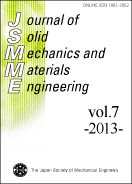All issues

Volume 7, Issue 5
Displaying 1-2 of 2 articles from this issue
- |<
- <
- 1
- >
- >|
Papers
-
Kazuto TANAKA, Shota MIZUNO, Hirokazu HONDA, Tsutao KATAYAMA, Shinichi ...2013Volume 7Issue 5 Pages 520-529
Published: 2013
Released on J-STAGE: September 30, 2013
JOURNAL FREE ACCESSPolyamide (PA) resin is anticipated to be a beneficial matrix of carbon fiber reinforced thermoplastics (CFRTP) because of its low cost and good bonding property to the carbon fiber. However, the well-known highly hygroscopic nature of PA demands that the influence of water absorption on the mechanical properties of carbon fiber/polyamide composites (CF/PA) be clarified. In this study, to evaluate the influence of water absorption on the mechanical properties of CF/PA composites, single fiber pull-out test for CF/PA model composites and tensile test for CF/PA composite were performed. For CF/PA6, and CF/PA66 model composites, water absorption at 80 °C caused significant reductions in interfacial shear strength. CF/PA12 model composites also showed a decrease in interfacial shear strength due to water absorption, but to a smaller degree compared with that of the other model composites tested. Oven drying was able to completely reverse the deleterious effect of water absorption on the interfacial shear strength in CF/PA6 and CF/PA12 model composites, but full restoration was not possible in CF/PA66 model composites. Oven drying was able to restore tensile strength in CF/PA6, CF/PA12 and CF/PA66 composites.View full abstractDownload PDF (1416K) -
Fumio NARITA, Yasuhide SHINDO, Masayuki SATO2013Volume 7Issue 5 Pages 530-539
Published: 2013
Released on J-STAGE: September 30, 2013
JOURNAL FREE ACCESSThis paper investigates analytically and experimentally the cyclic fatigue behavior in piezoelectric ceramics with a crack normal to the poling under alternating current (AC) electric fields. Fatigue tests were performed in three-point bending with the single-edge precracked-beam (SEPB) specimens, and numbers of cycles to failure under sinusoidal mechanical loads and AC electric fields were obtained. Finite element analysis was also conducted using a phenomenological model of domain wall motion, and the energy release rate was calculated. The effect of AC electric fields on the maximum energy release rate versus number of cycles to failure curve was then discussed. In addition, the fracture surfaces were examined by scanning electron microscopy to correlate with fatigue characteristics. The important conclusions are that when the AC electric fields with the same phase of the sinusoidal mechanical loads are applied to the cracked piezoelectric ceramics, the number of cycles to failure becomes smaller and the slope of the maximum energy release rate versus number of cycles to failure becomes steeper.View full abstractDownload PDF (2939K)
- |<
- <
- 1
- >
- >|